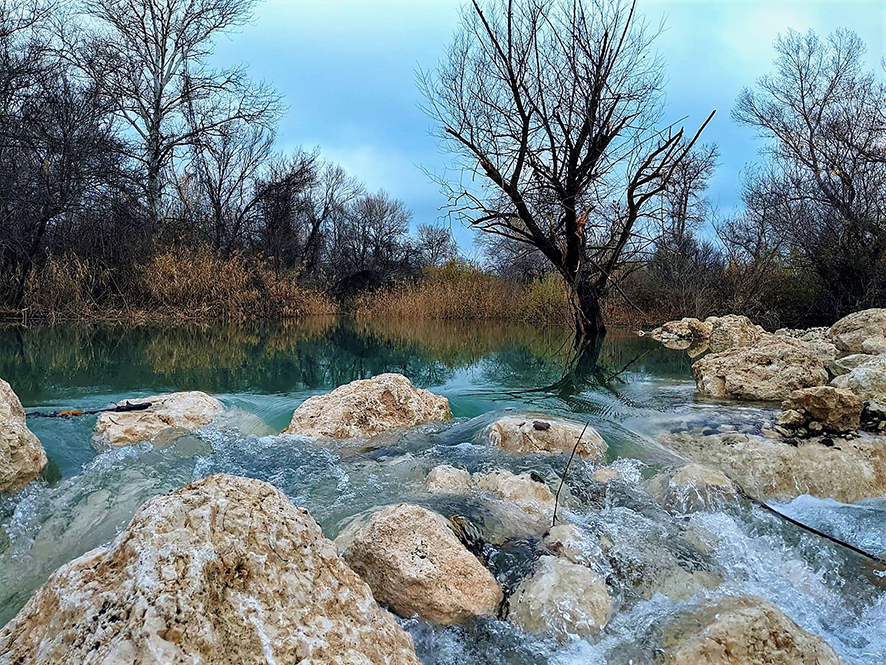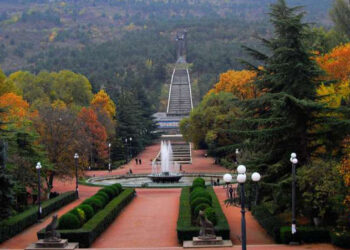In the picturesque region of Kakheti, Georgia, lies a landscape teeming with biodiversity and unique ecological treasures. However, this natural haven faces a significant challenge – the delicate balance between maintaining a living landscape and the looming threat of desertification. Recognizing the urgency of the situation, the Kakheti Steppes project, implemented by BirdLife partner SABUKO, in collaboration with local communities, is diligently working to protect biodiversity and conserve local species.
Restoring Gallery Forest and Grasslands
Building upon the successes of the previously funded “Restoring Gallery Forest and Grasslands in the Iori River Valley” project, the Kakheti Steppes project places a strong emphasis on the restoration of wildlife habitats and fostering collaboration with the pastoralist community. By reviving gallery forests and grasslands, critical habitats for focal species are rejuvenated, supporting their populations and ecological functions. Through thoughtful restoration initiatives, such as reforestation and habitat management, the project aims to preserve the rich biodiversity that thrives in these unique landscapes.
The first stage of the project covered the Chachuna Managed Reserve located in Georgia’s Dedoplistskaro municipality, which has faced a severe problem of degradation due to unregulated grazing, while the second phase covers Chachuna, Kotsakhura Range, Samukhi Valley and Vashlovani Protected Area, covering a territory of 25,000 ha in total.

The studies conducted on the spot in terms of biodiversity show that as a result of various measures implemented by SABUKO, such as the arrangement of fences to prevent the chaotic sheep movement and grazing, and installation of a gabion on the river, new plants characteristic to the floodplain forest have appeared and the area of the floodplain forest has expanded.
In the end, taking such measures can lead to partial restoration of unique floodplain forests on the ground and thus save the homes of local biodiversity, including rare species of animals and birds included on the Red List.
It is clear that through such measures and gabion, the situation has been significantly improved in terms of species restoration. As such, hydrologists and ichthyologists working on the ground claim that the amount of fish in the river, as well as other local species, has increased, which is thanks to the gabion. The first gabion arranged on the spot was a pilot project, and as it turned out to be successful. Now it is planned to arrange additional gabions for better results.
The gabion regulates water flow and supplies the algae and vegetation there with the water it needs. The gabion also reduced erosive processes and the washing away of the river banks around it through its regulatory function.
The Kakheti Steppes project also places special emphasis on the conservation of species such as the Imperial Eagle and Vulture. Through targeted conservation measures, including habitat restoration and the development of management plans, the project aims to safeguard the sites for these raptors.
Additionally, the project employs advanced monitoring techniques such as bird ringing – the attachment of a small, individually numbered metal or plastic tag to the leg or wing of a wild bird to enable individual identification. This helps in keeping track of the movements of the bird and its life history – and uses camera traps to gather valuable data on species populations, behavior, and movement patterns.

Sustainable Grazing and Rotational Grazing Schemes
Central to the project’s objectives is the promotion of sustainable grazing practices and the implementation of rotational grazing schemes. By carefully managing grazing activities across the steppes, the project ensures that the delicate balance between biodiversity conservation and the livelihoods of pastoralist communities is maintained. These efforts not only protect focal species but also contribute to the restoration of grassland biodiversity and the replenishment of soil carbon stocks. By involving farmers in the design and implementation of grazing schemes, the project fosters a sense of ownership and active participation in biodiversity conservation.

Mitigating Human-Wildlife Conflict and Promoting Coexistence
One of the critical challenges in conserving focal species is addressing human-wildlife conflict (HWC). The Kakheti Steppes project recognizes the importance of engaging local communities in understanding the ecological importance of focal species and finding ways to mitigate conflicts. By conducting surveys and assessments, the project identifies strategies to reduce HWC, such as implementing innovative solutions and raising awareness about the ecological benefits of coexistence. Through these measures, the project strives to create a harmonious balance between human activities and the conservation of focal species.

Expanding Protected Areas and Advocating for Policy Change
Recognizing the significance of protected areas in preserving biodiversity, the project works diligently to expand the network of protected areas and ensure ecological corridors. By preparing the comprehensive management plans of Samukhi PA and Dedoplistskaro Bioreserve, the project aims to secure the long-term conservation of focal species and their habitats. Moreover, through active engagement with policymakers and advocacy efforts, the project seeks to influence positive policy changes that support biodiversity conservation and the sustainable management of natural resources.
The Kakheti Steppes project is an example of dedicated efforts to protect biodiversity and conserve focal species in the face of environmental challenges. By restoring gallery forests and grasslands, promoting sustainable grazing practices, mitigating human-wildlife conflict, expanding protected areas, and advocating for policy change, the project embodies a holistic approach to conservation. With the generous support of Arcadia and the management expertise of Cambridge Conservation Initiative, the project brings together science, local knowledge, and community participation to safeguard the fragile balance between a living landscape and the looming threat of desertification.














